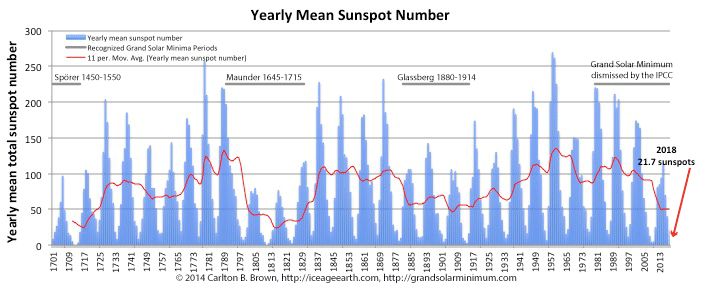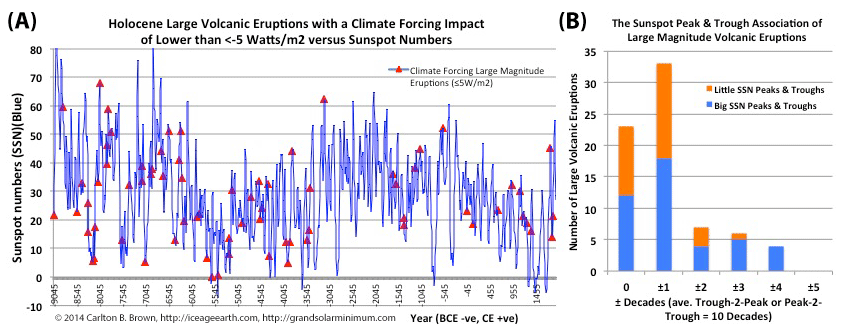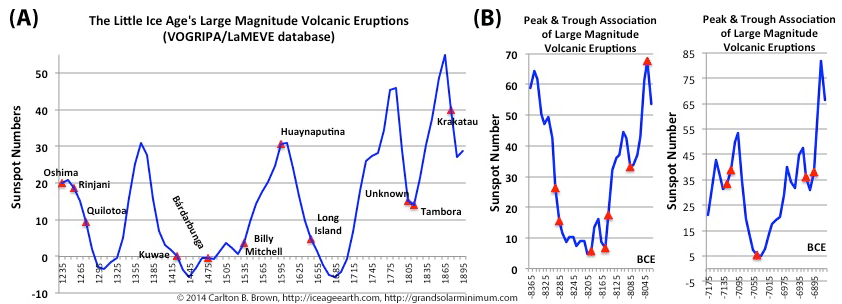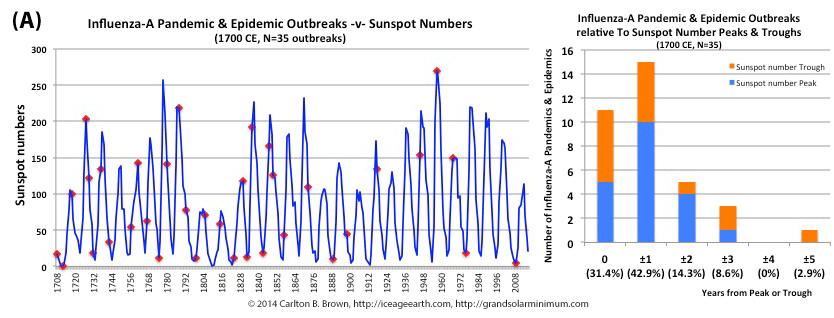Most large magnitude volcanic eruptions during the Little Ice Age happened during grand solar minimum or maximum periods (of sun spot numbers). The well known 8.2 kiloyear rapid climate change event was also associated with a cluster of climate forcing volcanic eruptions (greater than a -5 Watts/meter-squared forcing) during a deep grand solar minimum period.
Figure 5.2. A) VOGRIPA’s database of large magnitude volcanic eruptions (VEI 6 or 7), associated with the Little Ice Age were plotted against sunspot numbers.[i] The VEI 7 Rinjani volcanic eruption occurred at the grand solar maximum just prior to the Wolf minimum. You can see how 5 of the 11 large magnitude volcanic eruptions took place at or near the troughs of these grand solar minima periods. A further 3 of 11 large magnitude volcanic eruptions (VEI 6 or 7) occurred half way into a grand solar minimum, while the remaining 3 of 11 eruptions occurred at grand solar maximum sunspot peaks. B) These two figures highlight the association of large magnitude volcanic eruptions with grand solar maxima and minima (i.e., big peaks and deep troughs of sunspot numbers), as well as with the smaller peaks and troughs. The first of these two figures coincides with the 8.2-kiloyear rapid climate change event, the most abrupt and deepest cooling event in the last 8,500 years, which left its imprint in the climate record around the world.[ii],[iii],[iv],[v]
I conclude that grand solar minima and maxima represent high-risk periods associated with the “triggering” of climate-forcing volcanic eruptions.
Large magnitude volcanic eruptions trigger atmospheric and ocean circulatory system responses in the years following such an event. These can then induce longer-lived (decade to multi-decade) changes in the Arctic’s and North Atlantic’s climate. This in turn can have a major impact on the global ocean temperatures for several decades, which can lead to centennial-scale increases in the Northern Hemisphere’s glacier and sea ice.[vi],[vii],[viii],[ix],[x]
Scientists expert in volcanic activity-induced climate change (see the next paragraph’s citations) believe the Little Ice Age was caused by periods of abrupt and persistent summer cooling in the late 13th century and middle of the 15th century. These periods coincided with two of the most volcanically active half-centuries of the last millennium. The Little Ice Age also coincided with four successive grand solar minima, starting with the Wolf minimum in 1280.
A large magnitude volcanic eruption is believed to have triggered the Little Ice Age (Rinjani in 1257, a VEI 7 event),[xi] which was then followed by other large magnitude volcanic eruptions, roughly one every decade. These eruptions collectively resulted in volcanic sulfate levels during the 13th century (as revealed by ice core data) that was many times greater than in any other century during the last millennia. The cold periods resulting from this 13th century large-magnitude volcanism had an impact on the climate that was sustained over centennial timescales, and long after the eruptions’ volcanic aerosols were gone from the atmosphere.[xii],[xiii],[xiv],[xv],[xvi]
Low solar activity-induced alterations of atmospheric circulations are thought to play an important role in glacier and sea ice expansion processes.[xvii] The North Atlantic Oscillation is a dominant Northern Hemisphere atmospheric circulation, and is the key determinant of the winter climate over the North Atlantic.[xviii],[xix],[xx],[xxi],[xxii],[xxiii],[xxiv] A prolonged negative phase of the North Atlantic Oscillation was experienced during the Little Ice Age, which was associated with increased ice accumulation during the Little Ice Age.[xxv],[xxvi]
Importantly, the North Atlantic Oscillation is coupled to the upper atmosphere (i.e., the stratosphere) by some complex physical processes,[xxvii],[xxviii] and its phase and strength are correlated with geomagnetic activity (i.e., earth magnetism), which is known to be modified by magnetized solar wind.[xxix],[xxx],[xxxi] The North Atlantic Oscillation is also modified by changes in the loading of the stratosphere with volcanic aerosols.[xxxii],[xxxiii]
The above paragraphs collectively highlight that climate-forcing volcanism and the North Atlantic Oscillation were instrumental in the Little Ice Age’s cold climate and ice accumulation mechanism. This mechanism led to an increase in sea ice entering the sub-polar North Atlantic region from the Arctic (referred to as “sea ice exports”). These sea ice exports in turn weakened the North Atlantic branch of the Atlantic thermohaline circulation (i.e., a salt concentration and temperature-driven ocean circulation system), and reduced warm water entry into the Arctic region. The increased sea ice exports and changes to the ocean circulation system “reinforced” the ice generating process, which led to centennial-scale glacier ice expansion in the Arctic (viz. glacier ice expansion mechanism).[xxxiv],[xxxv],[xxxvi],[xxxvii],[xxxviii]
Click on this page and download a free copy of my book “Revolution: Ice Age Re-Entry,” and read more about this topic in Chapter 5.
[i] Data: (1) Helen Sian Crosweller et al., “Global database on large magnitude explosive volcanic eruptions (LaMEVE).” Journal of Applied Volcanology Society and Volcanoes 20121:4. https://doi.org/10.1186/2191-5040-1-4. Volcano Global Risk Identification and Analysis Project database (VOGRIPA), British Geological Survey. Data Access: http://www.bgs.ac.uk/vogripa/. Data downloaded 07/05/2018. (2) S.K. Solanki et al., 2004, “An unusually active Sun during recent decades compared to the previous 11,000 years.” Nature, Volume 431, No. 7012, 1084-1087, 28 October 2004. Data: Solanki, S.K., et al. 2005. 11,000 Year Sunspot Number Reconstruction. IGBP PAGES/World Data Center for Paleoclimatology. Data Contribution Series #2005-015. NOAA/NGDC Paleoclimatology Program, Boulder CO, USA. https://www.ncdc.noaa.gov/paleo-search/study/5780. Downloaded 05/06/2018. (3) Takuro Kobashi et al., 2017, “Volcanic influence on centennial to millennial Holocene Greenland temperature change.” Scientific Reports, 7, 1441. doi: 10.1038/s41598-017-01451-7. Data provided by the National Centers for Environmental Information, NESDIS, NOAA, U.S. Department of Commerce. https://www.ncdc.noaa.gov/paleo-search/study/22057. Data accessed 21/08/2018. Personal Research: (1) Figure 5.2.A: The 11 total VEI 6 and 7 eruptions between 1235 and 1885 were extracted from the LaMEVE database and graphically plotted as discrete events on the above-cited Solanki et al. sunspot number data within this same period. In this manner, the occurrence of VEI 6-7 eruptions can be viewed relative to the grand solar maximum or minimum, or a smaller sub-peak or sub-trough of sunspot numbers going into or coming out of a grand solar minimum trough. (2) Figure 5.2.B: Two periods running from grand solar maxima-to-minima-to-maxima were extracted from the above-cited Solanki et al. sunspot number data. The corresponding climate forcing volcanic eruptions from the Takuro Kobashi, et al. volcanic eruption data (the same as utilized for Figure 5.1.A) were plotted in the periods that they occurred. This highlights the association of large climate-forcing volcanic eruptions with either a grand solar maximum or minimum, or a smaller sub-peak or sub-trough of sunspot numbers going into or coming out of a grand solar minimum.
[ii] R. B. Alley et al., “Holocene climatic instability: A prominent, widespread event 8200 year ago.” Geology ; 25 (6): 483–486. doi: https://doi.org/10.1130/0091-7613(1997)025<0483:HCIAPW>2.3.CO;2.
[iii] Kaarina Sarmaja-Korjonen and H. Seppa, 2007, “Abrupt and consistent responses of aquatic and terrestrial ecosystems to the 8200 cal. year cold event: a lacustrine record from Lake Arapisto, Finland”. The Holocene 17 (4): 457–467. doi:10.1177/0959683607077020.
[iv] D.C. Barber et al., 1999, “Forcing of the cold event of 8,200 years ago by catastrophic drainage of Laurentide lakes.” Nature Volume 400, 344–348 (22 July 1999). doi:10.1038/22504.
[v] Christopher R W Ellison et al., 2006, “Surface and Deep Ocean Interactions During the Cold Climate Event 8200 Years Ago.” Science. 2006 Jun 30;312(5782):1929-32. DOI10.1126/science.1127213.
[vi] J. Slawinska and A. Robock, 2018, “Impact of Volcanic Eruptions on Decadal to Centennial Fluctuations of Arctic Sea Ice Extent during the Last Millennium and on Initiation of the Little Ice Age.” J. Climate, 31, 2145–2167, https://doi.org/10.1175/JCLI-D-16-0498.1.
[vii] Didier Swingedouw et al., 2015, “Bidecadal North Atlantic ocean circulation variability controlled by timing of volcanic eruptions.” Nature Communications. 6:6545 | DOI: 10.1038/ncomms7545.
[viii] D.O. Zanchettin et al., 2013, “Background conditions influence the decadal climate response to strong volcanic eruptions.” Journal of Geophysical Research Atmos., 118, 4090–4106, doi:10.1002/jgrd.50229.
[ix] Y. Zhong et al., “Centennial-scale climate change from decadally-paced explosive volcanism: a coupled sea ice-ocean mechanism.” Climate Dynamics (2011) 37: 2373. https://doi.org/10.1007/s00382-010-0967-z.
[x] G.H. Miller et al., 2012, “Abrupt onset of the Little Ice Age triggered by volcanism and sustained by sea-ice/ocean feedbacks.” Geophysical Research Letters, 39, L02708, doi:10.1029/2011GL050168.
[xi] C. Newhall et al., 2018, Anticipating future Volcanic Explosivity Index (VEI) 7 eruptions and their chilling impacts: Geosphere, v. 14, no. 2, p. 1–32, doi:10.1130/GES01513.1.
[xii] J. Slawinska and A. Robock, 2018, “Impact of Volcanic Eruptions on Decadal to Centennial Fluctuations of Arctic Sea Ice Extent during the Last Millennium and on Initiation of the Little Ice Age.” J. Climate, 31, 2145–2167, https://doi.org/10.1175/JCLI-D-16-0498.1.
[xiii] G. H. Miller et al., 2012, “Abrupt onset of the Little Ice Age triggered by volcanism and sustained by sea-ice/ocean feedbacks.” Geophysical Research Letters, 39, L02708, doi:10.1029/2011GL050168.
[xiv] F. Lehner et al., 2013, “Amplified inception of European Little Ice Age by sea ice–ocean–atmosphere feedbacks.” J. Climate, 26, 7586–7602. https://doi.org/10.1175/JCLI-D-12-00690.1.
[xv] C. Gao et al., 2008, “Volcanic forcing of climate over the past 1500 years: An improved ice core‐based index for climate models.” Journal of Geophysical Research, 113, D23111, doi: 10.1029/2008JD010239. [See Figure 2, page 5].
[xvi] Y. Zhong et al., “Centennial-scale climate change from decadally-paced explosive volcanism: a coupled sea ice-ocean mechanism.” Climate Dynamics (2011) 37: 2373. https://doi.org/10.1007/s00382-010-0967-z.
[xvii] J. Slawinska and A. Robock, 2018, “Impact of Volcanic Eruptions on Decadal to Centennial Fluctuations of Arctic Sea Ice Extent during the Last Millennium and on Initiation of the Little Ice Age.” J. Climate, 31, 2145–2167, https://doi.org/10.1175/JCLI-D-16-0498.1.
[xviii] V. Bucha, “Geomagnetic activity and the North Atlantic Oscillation.” Studia Geophysica et Geodaetica. July 2014, Volume 58, Issue 3, 461–472. https://doi.org/10.1007/s11200-014-0508-z.
[xix] J. G. Pinto and C. C. Raible, 2012, “Past and recent changes in the North Atlantic oscillation.” WIREs Climate Change, 3: 79-90. doi:10.1002/wcc.150.
[xx] Jesper Olsen et al., “Variability of the North Atlantic Oscillation over the past 5,200 years.” Nature Geoscience Volume 5, 808–812 (2012). DOI: 10.1038/NGEO1589.
[xxi] P. Thejll et al., “On correlations between the North Atlantic Oscillation, geopotential heights, and geomagnetic activity.” Geophysical Research Letters, 30 (6), 1347, 2003. doi:10.1029/2002GL016598.
[xxii] J.W. Hurrell et al., 2013, “An Overview of the North Atlantic Oscillation.” In The North Atlantic Oscillation: Climatic Significance and Environmental Impact (eds J. W. Hurrell, Y. Kushnir, G. Ottersen and M. Visbeck). doi:10.1029/134GM01.
[xxiii] Jesper Olsen et al., “Variability of the North Atlantic Oscillation over the past 5,200 years.” Nature Geoscience Volume 5, 808–812 (2012). DOI: 10.1038/NGEO1589.
[xxiv] A. Mazzarella and N. Scafetta, 2012, “Evidences for a quasi 60-year North Atlantic Oscillation since 1700 and its meaning for global climate change.” Theoretical Applied Climatology 107, 599-609. DOI: 10.1007/s00704-011-0499-4.
[xxv] T. Bradwell et al., 2006, “The Little Ice Age glacier maximum in Iceland and the North Atlantic Oscillation: evidence from Lambatungnajökull, southeast Iceland.” Boreas, 35: 61-80. doi:10.1111/j.1502-3885.2006.tb01113.x.
[xxvi] Jesper Olsen et al., “Variability of the North Atlantic Oscillation over the past 5,200 years.” Nature Geoscience Volume 5, 808–812 (2012). DOI: 10.1038/NGEO1589.
[xxvii] M.H. Ambaum and B.J. Hoskins, 2002, “The NAO Troposphere–Stratosphere Connection.” J. Climate, 15, 1969–1978, https://doi.org/10.1175/1520-0442(2002)015<1969:TNTSC>2.0.CO;2.
[xxviii] V. Bucha, “Geomagnetic activity and the North Atlantic Oscillation.” Studia Geophysica et Geodaetica. July 2014, Volume 58, Issue 3, 461–472. https://doi.org/10.1007/s11200-014-0508-z.
[xxix] P. B. Thejll et al., “On correlations between the North Atlantic Oscillation, geopotential heights, and geomagnetic activity.” Geophysical Research Letters, 30 (6), 1347, 2003. doi:10.1029/2002GL016598.
[xxx] H. Lu et al., 2008, “Possible solar wind effect on the northern annular mode and northern hemispheric circulation during winter and spring.” Journal of Geophysical Research, 113, D23104, doi: 10.1029/2008JD010848.
[xxxi] V. Bucha, “Geomagnetic activity and the North Atlantic Oscillation.” Studia Geophysica et Geodaetica. July 2014, Volume 58, Issue 3, 461–472. https://doi.org/10.1007/s11200-014-0508-z.
[xxxii] J.W. Hurrell et al., 2013, “An Overview of the North Atlantic Oscillation.” In The North Atlantic Oscillation: Climatic Significance and Environmental Impact (eds J. W. Hurrell, Y. Kushnir, G. Ottersen and M. Visbeck). doi:10.1029/134GM01.
[xxxiii] J.W. Hurrell et al., 2013, “An Overview of the North Atlantic Oscillation.” In The North Atlantic Oscillation: Climatic Significance and Environmental Impact (eds J. W. Hurrell, Y. Kushnir, G. Ottersen and M. Visbeck). doi:10.1029/134GM01. [Citing Robock and Mao, 1992; Kodera, 1994; Graf et al., 1994; Kelley et al., 1996.].
[xxxiv] J. Slawinska and A. Robock, 2018, “Impact of Volcanic Eruptions on Decadal to Centennial Fluctuations of Arctic Sea Ice Extent during the Last Millennium and on Initiation of the Little Ice Age.” J. Climate, 31, 2145–2167, https://doi.org/10.1175/JCLI-D-16-0498.1.
[xxxv] F. Lehner et al., 2013, “Amplified inception of European Little Ice Age by sea ice–ocean–atmosphere feedbacks.” J. Climate, 26, 7586–7602. https://doi.org/10.1175/JCLI-D-12-00690.1.
[xxxvi] C. Newhall et al., 2018, “Anticipating future Volcanic Explosivity Index (VEI) 7 eruptions and their chilling impacts.” Geosphere, v. 14, no. 2, p. 1–32, doi:10.1130/GES01513.1.
[xxxvii] Odd Helge Otterå et al., “External forcing as a metronome for Atlantic multidecadal variability.” Nature Geoscience Volume 3, 688–694 (2010).
[xxxviii] Y. Zhong et al., “Centennial-scale climate change from decadally-paced explosive volcanism: a coupled sea ice-ocean mechanism.” Climate Dynamics (2011) 37: 2373. https://doi.org/10.1007/s00382-010-0967-z.







Recent Comments